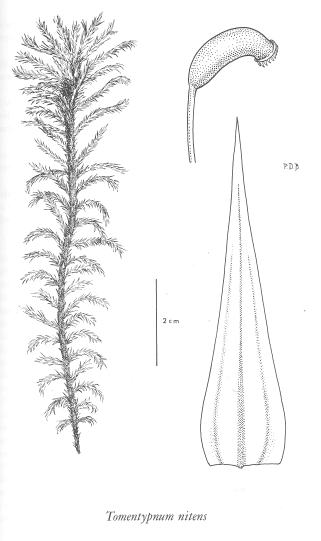Click on the image below to view an
expanded illustration for this species.

|
Species description:
Genus name denoting a hairy moss, in reference to the abundance of rhizoids on the stem of most specimens of this moss. Species name meaning shining or polished, in reference to the leaves.
Reproduction:
Sporophytes rare, red-brown, sporangia cylindric, curved, seta elongate, maturing in summer
Distinguishing characteristics:
The wetland, usually calcareous habitat, the erect, somewhat pinnately branched plants, the regularly pleated leaves, the glossy yellow-green colour, the usual felt of dark red-brown rhizoids on the stems and lower part of the leaf midrib are all useful features.
Habit:
Forming turf-like mats of erect, regularly branched, glossy bright yellow-green to golden plants in which the stem is often matted with red-brown rhizoids.
Similar Species:
T. falcifo/ium has falcate-secund leaves, otherwise it is similar to T. nitens. Orthothecium chryseum, although it has pleated leaves, is usually irregularly branched or unbranched, lacks abundant rhizoids on the stem, and is reddish to golden-green. Homa/othecium species do not occur in marshy habitats but show colour, pleating and form similar to T. nitens. Brachythecium species in the same habitat as T. nitens lack pleated leaves and abundant stem rhizoids. Unfortunately, some populations of T. nitens lack abundant stem rhizoids; however, in such cases the habitat and strongly tapered leaves are usually diagnostic, although confusion with Brachythecium or Orthotheciumis possible.
|
